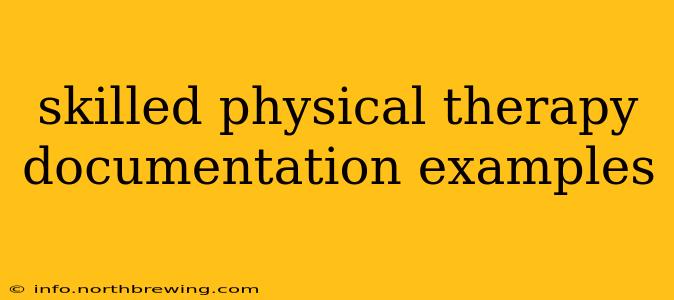Effective physical therapy documentation is crucial for demonstrating the medical necessity of services, ensuring appropriate reimbursement, and facilitating clear communication among healthcare professionals. This guide provides examples of skilled physical therapy documentation, highlighting key elements and best practices. Remember, these are examples and should be adapted to reflect the individual patient's specific needs and progress. Always adhere to your facility's specific documentation guidelines.
What Makes Physical Therapy Documentation "Skilled"?
Skilled physical therapy documentation goes beyond simply recording the exercises performed. It emphasizes the clinical judgment, specialized knowledge, and advanced techniques employed by the therapist. This includes:
- Detailed assessment: Thorough evaluation of the patient's condition, including functional limitations, pain levels, and goals.
- Treatment plan: A customized plan that addresses the patient's specific needs and incorporates skilled interventions.
- Progress notes: Regular documentation of the patient's response to treatment, modifications made to the plan, and overall progress towards goals.
- Justification of skilled care: Clear explanation of why the services provided require the expertise of a physical therapist, rather than an aide or other less-skilled provider. This often focuses on complex interventions, patient education, or the need for ongoing clinical judgment.
Example Documentation Scenarios & Skilled Interventions:
Let's explore several scenarios and see how skilled interventions and their rationale can be documented effectively.
Scenario 1: Post-Surgical Knee Replacement
Patient: 65-year-old female post-total knee arthroplasty (TKA), 2 weeks post-op.
Assessment: Patient presents with significant pain (8/10) in the right knee, limited ROM (0-90 degrees), and decreased weight-bearing capacity. Reports significant swelling and muscle atrophy in the right leg. Demonstrates difficulty with transfers and gait.
Interventions:
- Manual therapy: Grade II mobilization to address joint restrictions, improving ROM. Rationale: Manual therapy requires specialized knowledge of joint mechanics and potential contraindications post-surgery.
- Therapeutic exercise: Active-assistive range of motion exercises, progressing to active exercises as tolerated. Initiated closed-chain exercises for weight-bearing. Rationale: Specific exercise progression is crucial for post-surgical rehabilitation to avoid re-injury and promote optimal healing.
- Gait training: Initiated with assistive devices (walker), progressing to partial weight-bearing as tolerated. Rationale: Gait training is a skilled intervention requiring assessment of balance and safety, and modification based on patient response.
- Patient education: Instructed on proper joint protection strategies, pain management techniques, and home exercise program. Rationale: Patient education is a critical component of a successful rehabilitation program, requiring expertise in explaining complex medical information in an understandable manner.
Progress Note: Patient tolerated session well. Noted improved ROM (0-105 degrees) after manual therapy. Increased weight-bearing capacity with walker assistance. Continued patient education on home exercise program. Plan: Continue with current interventions, progressing exercises and weight-bearing as tolerated.
Scenario 2: Chronic Low Back Pain
Patient: 40-year-old male with chronic low back pain due to degenerative disc disease.
Assessment: Patient presents with chronic low back pain (5/10), decreased lumbar flexion and extension, and muscle spasms. Reports limitations in activities of daily living (ADLs), including difficulty with lifting and bending.
Interventions:
- Manual therapy: Soft tissue mobilization to address muscle spasms and myofascial restrictions. Rationale: Identifying and treating specific muscle restrictions requires advanced knowledge of anatomy and palpation skills.
- Therapeutic exercise: Core strengthening exercises, lumbar stabilization exercises, and flexibility exercises. Rationale: Proper exercise selection for chronic low back pain requires careful consideration of the patient's specific limitations and potential for re-injury.
- Neuromuscular re-education: Emphasis on proper body mechanics and posture correction. Rationale: Neuromuscular re-education addresses the underlying biomechanical factors contributing to pain, which requires advanced knowledge of movement patterns.
- Functional training: Exercises designed to improve functional mobility and ADLs. Rationale: Functional training integrates movements relevant to daily life, improving the patient’s ability to perform activities independently.
Progress Note: Patient reported decreased pain (4/10) after treatment. Improved lumbar flexion and extension. Able to perform more repetitions of core strengthening exercises. Plan: Continue current interventions, progressing the intensity and difficulty of exercises as tolerated. Introduce light weightlifting to further strengthen the core.
Scenario 3: Stroke Rehabilitation
Patient: 70-year-old male with right-sided hemiparesis following a stroke.
Assessment: Patient demonstrates significant weakness on the right side, impaired balance, and difficulty with ambulation. Speech therapy is involved.
Interventions:
- Neuromuscular electrical stimulation (NMES): Applied to the right extremities to facilitate muscle re-education and improve strength. Rationale: NMES is a skilled modality requiring precise placement of electrodes and careful monitoring of patient response.
- Balance training: Utilizing various balance exercises and strategies to improve stability and reduce fall risk. Rationale: Balance training in post-stroke patients requires specialized knowledge of compensatory techniques and safety precautions.
- Functional training: Emphasis on ADLs such as dressing, grooming, and transfers. Rationale: Facilitating independence in daily activities post-stroke requires a skilled approach tailoring the training to each individual’s needs.
Progress Note: Patient demonstrated improved strength and balance during today's session. Able to complete transfers with minimal assistance. Continued practicing ADLs. Plan: Continue with current interventions, progressing the difficulty of exercises as tolerated.
These examples illustrate the importance of comprehensive documentation that clearly demonstrates the skilled nature of physical therapy services. Remember to always tailor your documentation to the individual patient and their specific needs. Regularly review your documentation practices to ensure they meet all professional and regulatory standards.
